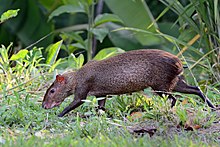| Dasyproctidae | |
|---|---|

| |
| Central American agouti, D. punctata | |
| Scientific classification | |
| Domain: | Eukaryota |
| Kingdom: | Animalia |
| Phylum: | Chordata |
| Class: | Mammalia |
| Order: | Rodentia |
| Superfamily: | Cavioidea |
| Family: | Dasyproctidae Gray 1825 |
| Type genus | |
| Dasyprocta Illiger, 1811
| |
| Genera | |
Dasyproctidae is a family of large South American rodents, comprising the agoutis and acouchis.[1] Their fur is a reddish or dark colour above, with a paler underside. They are herbivorous, often feeding on ripe fruit that falls from trees. They live in burrows, and, like squirrels, will bury some of their food for later use.[2]
Dasyproctids exist in Central and South America, which are the tropical parts of the New World. The fossil record of this family can be traced back to the Late Oligocene (Deseadan in the SALMA classification).
As with all rodents, members of this family have incisors, pre-molars, and molars, but no canines. The cheek teeth are hypsodont and flat-crowned.
- ^ Woods, C.A.; Kilpatrick, C.W. (2005). "Infraorder Hystricognathi". In Wilson, D.E.; Reeder, D.M (eds.). Mammal Species of the World: A Taxonomic and Geographic Reference (3rd ed.). Johns Hopkins University Press. pp. 1538–1600. ISBN 978-0-8018-8221-0. OCLC 62265494.
- ^ Bishop, Ian (1984). Macdonald, D. (ed.). The Encyclopedia of Mammals. New York: Facts on File. p. 701. ISBN 0-87196-871-1.